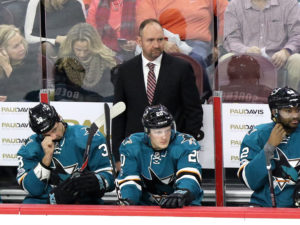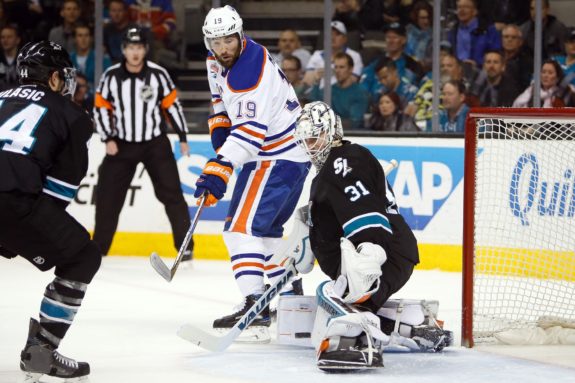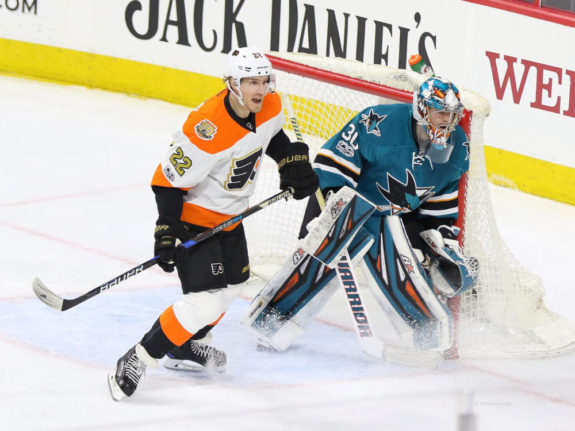We continue our season review of the San Jose Sharks, this is the fourth piece in our series. We’ll cover the goalies in this piece.
Sharks Season Review:
- The Main Points
- The Forwards
- The Defense
- The Goalies
- Salary Cap and Roster (coming next)
San Jose required only two goalies for the entire season, starter Martin Jones and backup Aaron Dell. Jones had a down season, but a solid playoff series. Dell made his NHL debut and proved himself an excellent backup.
The Starter

Coach Peter DeBoer played Martin Jones a lot last season, his 89 game workload (including the playoffs) was by far the most in the league. One has to go back over a decade to find a goalie who played 90 or more, and his name is Martin Brodeur.
This season, one question came up frequently: is Martin Jones being used too much, especially on top of the heavy workload last season? Entering the playoffs, Jones had played more over the last two seasons than any other goalie. No other goalie was even close.
Jones finished the 2016-17 season tied for third in games played and second in ice time. Among players with 30 or more appearances, Jones finished 27th in save percentage and was notably better in the 2016 portion of the season (save percentage .919) than the 2017 portion (.905). His save percentage declined every month, starting in November at .924 and finishing March (plus three games in April) at .899.

DeBoer, however, was convinced his goalie would not get fatigued and practically sneered at these questions when they were raised. Whether the issues were on Jones or not, the results suggest he didn’t get better from all his playing time.
The Backup
Whatever DeBoer believed, his use of Jones wasn’t due to a case of an untrustworthy backup. Jones’ backup was superb. Dell played in just 20 games (17 starts). He had one poor outing, that’s it. In 16 of 17 starts, he gave up three goals or less, and two or less in twelve starts. His record was a strong 11-6-1, with two of the six losses by the score of 1-0.
For the season, Dell’s save percentage was .931. Among goalies who played 20 or more games, Dell equaled Sergei Bobrovsky for the highest save percentage in the league. His ‘goals against average’ (GAA) of 2.00 was the best in the league. Dell’s sporadic work made his results all the more impressive.

So why did Dell play so little? There has never been a good answer to this question and there probably won’t be.
One factor helping Dell’s results, he didn’t play much against the elite teams. He faced playoff teams only six times. He had two periods of mop-up duty against Pittsburgh, three games against Calgary (two starts, plus one period in relief), a start against St. Louis and two periods in relief work against Boston. In total, the equivalent of less than five full games of work against playoff teams, or roughly a quarter of Dell’s playing time.
The Playoffs
In the playoffs, it was all Martin Jones. He delivered a solid series, with a 1.75 GAA and .935 save percentage. Unfortunately, this was not good enough, as the Sharks lost in the opening round in six games. San Jose won just one of the close games in the series. In games 2 and 3, Jones allowed just three goals in 58 shots, nearly a .950 save percentage – and lost both games as the Sharks were shut out in both.
Jones was excellent in Game 5, with 44 saves. Edmonton, however, out shot the sluggish Sharks 35-14 from the second period through the overtime. While Jones kept the Sharks alive with several brilliant saves, it was another close loss. Edmonton scored the winning goal 18 minutes into overtime.
In the final game of the season, Jones allowed a pair of breakaway goals. These proved the difference in the game, as the Sharks only scored once. Cam Talbot, the Oilers goalie, stopped a Sharks breakaway along with numerous other quality chances. It was the only game in the series where goalie play decided the game.
Expectations and Results
The expectations were high for Jones and low for Dell. Jones fell below expectations, his .912 save percentage was 14th among the 16 playoff starters. Still, he delivered strong, if not timely work in the playoff series.
Of concern going forward, teams seem to have found two weaknesses in Jones’ game, the high glove hand and the five hole. Encouraging for Jones, for the second straight season, he lifted his game in the playoffs. Better to have an average regular season goalie and top playoff goalie than the other way around.
Dell meanwhile, blew past expectations. At age 27, Dell is above the age limit for an NHL rookie, but for all intents and purposes, this was his rookie season. He proved he belongs in the NHL.
The bigger mystery is the use of the two players. One was overused, the other underused.
Overall, the Sharks goaltending results finished below expectations, as San Jose’s goaltending was middle of the pack. The starter was below average and the backup excellent, a combination which put the Sharks right about the league average. San Jose married average goalie play with excellent defense to get good team results, somewhat hiding the goaltending issue. The Sharks allowed the third fewest shots on goal. Good team discipline kept them off the penalty kill, they took the second fewest minor penalties. The combination resulted in just 200 goals allowed, fifth best in the league.
Should Dell and Jones remain the goalie tandem next season, the Sharks look to be in good shape. Both have another year on their contract, extending Jones beyond this is a priority for the offseason.
Still, goalie performance is notoriously hard to predict and even good goalies have off seasons. As this season demonstrated.